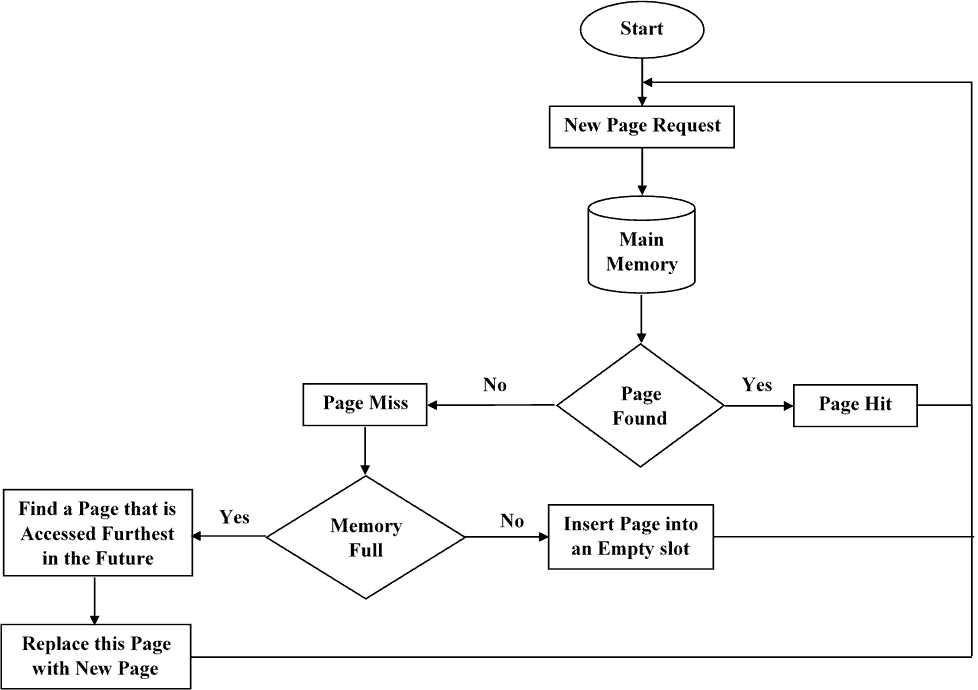1. Introduction
Memory Management is an important aspect of operating systems for optimizing their performance. The optimal page replacement (OPT) algorithm is a memory management technique. It minimizes the number of page faults by predicting future accesses and replacing the least recently used pages. In fact, it achieves the minimum number of page faults in theory. However, it is not practical due to the need of knowledge of future memory references. However, it provides a benchmark for evaluating other page replacement algorithms, such as first in first out (FIFO) and least recently used (LRU) algorithms.
In this tutorial, we’ll first understand the basic terms of memory management, such as paging, page request, page hit, page fault, and page replacement. Next, we’ll study the working principle of the OPT algorithm. Then, we’ll walk through an illustrative example. At last, we’ll discuss its potential advantages and disadvantages before concluding the article.
2. Background
Memory management involves efficiently allocating, utilizing, and releasing memory resources. It ensures that each running process has access to the required memory while preventing conflicts and maximizing overall system performance. Let’s discuss the key terms in memory management: paging, page request, page hit, page fault, and page replacement.
Paging refers to dividing physical memory into fixed-size blocks called pages. It enables a computer system to transfer data among various memories, such as register, cache, main memory (RAM), and secondary storage (HDD or SSD).
A page request represents a specific memory address indicated by a page number that a process wants to access. A page hit occurs when the requested page is already present in the main memory.
On the other hand**,** a page fault (or miss) happens when a requested page is unavailable in the main memory. The operating system triggers a page fault handler to fetch the required page from secondary storage into the main memory.
Page replacement refers to replacing pages in the main memory to accommodate the new pages. The page fault handler executes a page replacement algorithm to manage the page replacement.
3. Optimal Page Replacement (OPT) Algorithm
The main idea behind the OPT algorithm is to replace a page that will not be needed for the longest period of time in the future. It predicts which page will be accessed furthest ahead and replaces it when a page fault occurs. Thus, the operating system needs information on future memory references to implement it. However, it is not practical in real-world scenarios.
The steps of the OPT algorithm are depicted by the flowchart:

In particular, the OPT algorithm starts with a set of empty slots in the main memory and performs the following steps for each page request.
First, it checks if the requested page is already present in the main memory. If so, it detects a page hit and proceeds to the next page request.
If the page is not found in the main memory, it triggers a page miss and checks if the main memory is full.
When the main memory is not full, it loads the requested page into an empty slot and moves on to the next page request.
If the main memory is full, it first makes room for the new page. To do so, it finds the page that will not be accessed for the longest period in the future. After that, it replaces the selected page with the newly requested page. This ensures that the main memory remains occupied by the most relevant and frequently accessed pages.
4. An Illustrative Example
Let’s consider an example with page references and three slots in the main memory. This will help us grasp how the OPT algorithm works. Now, we’ll solve this example using the OPT algorithm for a better understanding. Herein, we’ll use
to indicate a page fault (or miss) and
to denote a page hit.
Initially, the memory is empty, and the OPT algorithm inserts page in the memory. It is a page miss:

Next, the algorithm inserts in the memory as neither it’s full nor
is present. This is also a page miss:

Similarly, it adds because it is not in the memory:

Now, the memory is full and does not contain page , again causing a page miss. The algorithm replaces page
with page
since page
will not be used in future:

The page is already in memory, resulting in a page hit with no need for page replacement:

With the main memory full and page missing, another page miss occurs. The algorithm swaps page
with page
as it is not used in the future:

Next, the algorithm finds that page is already loaded in the memory. It is a page hit:

The memory doesn’t contain page , causing a page miss again. In this case, page
is accessed furthest ahead in the page references. So, it replaces page
with page
:

Subsequently, the page is available in the memory. Therefore, it is a page hit:

Likewise, it finds that the page is in the memory, again leading to a page hit:

Hence, the total number of page hits and misses (or faults) are and
, respectively.
5. Advantages and Disadvantages
The advantages and disadvantages of the OPT algorithm are:
Advantages
Disadvantages
The OPT algorithm selects replacement pages based on future memory references, ensuring optimal memory utilization.
The OPT algorithm relies on perfect knowledge of future page references, which is unrealistic.
It can efficiently detect and correct single-bit errors in data without the need for retransmission.
It has a high computational cost as it analyses all the future page references.
The OPT algorithm sets an upper bound to evaluate the efficacy of other page replacement algorithms.
It lacks adaptability to changing patterns of page references.
6. Conclusion
In this article, we discussed the OPT algorithm that minimizes page faults in theory and is a benchmark for practical algorithms.
We then use an illustrative example to explain how the OPT algorithm works. In the end, we discuss the potential advantages and disadvantages of the OPT algorithm.